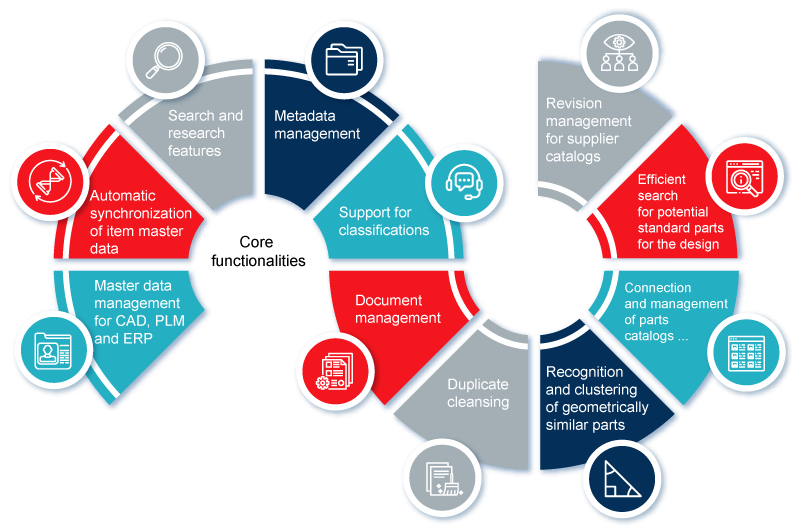Being able to reuse parts or assemblies is important for the reduction of development and production costs. Engineers or designers usually spend more than half of their working time searching for parts or components or configuring parts. However, it is not always necessary to create new components, since comparable components already exist somewhere in the system. A parts management system can perfectly support engineers in searching, finding and managing components.
Too many parts in CAD system can be a problem
Sometimes more than one CAD system is in use in a company. These different CAD systems often access different storage locations. Often outdated parts and numerous duplicates are stored. In most cases, the evolved CAD system structure and the distributed data in the other systems such as ERP and PLM do not offer any standardization. The master data can therefore be described as chaotic in many cases.
All CAD systems include functions for storing and retrieving CAD data. The CAD system database usually stores the drawing number, revision status, part designation, material identifier, etc. Of course, this data can also be used for searching or retrieval. This rather sparse data is rarely sufficient to find a specific part quickly and easily.
In addition to the actual CAD model data, other parts or assembly information includes, for example, parts lists, drawings, FEM calculations, and NC programs. Structured storage is particularly important here. The entire data and documents represent the knowledge base for the company. The efficient further use or reuse of data is of great importance. For example, it can help to achieve a faster time-to-market.
Core functionalities

A parts management system usually includes certain functionalities. These include, among others:
- Master data management for CAD, PLM and ERP
- Automatic synchronization of item master data
- Search and research features
- Metadata management
- Support for classifications
- Document management
- Duplicate cleansing
- Recognition and clustering of geometrically similar parts
- Connection and management of parts catalogs or standard parts libraries
- Efficient search for potential standard parts for the design
- Revision management for supplier catalogs
The essential function of the parts management is the search function. This search function should be as powerful and intelligently designed as possible. Information should be found quickly via the metadata, for example. Duplicates should be easy to find and clean up in the system. Geometrically similar, already existing parts should also be recognized. Search functions that are not limited to a single storage location but that can search through various storage locations are also particularly advantageous for this purpose. At the same time, parts management should also include appropriate functions for maintaining the data.
What are the goals of using parts management?
Cost reduction in product development is certainly the driving factor when considering efficient parts management. Fewer new designs usually mean lower production costs due to the reduced parts inventory. The more parts that can be reused in production the better. Efficient parts management can ensure quantity effects in production and purchasing. Of course, interdepartmental cooperation within the company is also important for this.
Another goal, in addition to identifying duplicates and cleaning them up, is the efficient classification of master data and the automatic clustering of geometrically similar components.
Conclusion
Time-to-market can be shortened by efficient parts management. For this, engineers and designers need an efficient search function in the CAD system. A geometric similarity search can quickly identify purchased and proprietary parts. A good overview of all available parts can save costs already in the development phase and reduce errors at the same time.